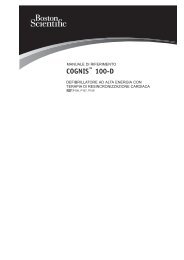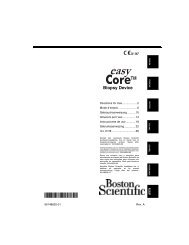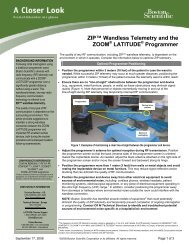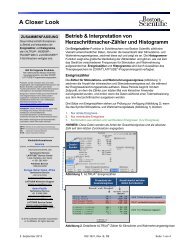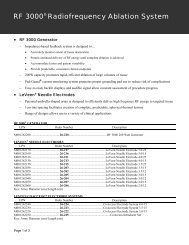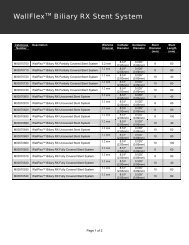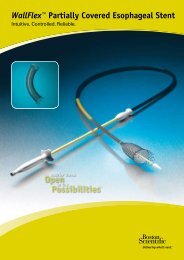Battery Status Information for Boston Scientific Pacemakers and ...
Battery Status Information for Boston Scientific Pacemakers and ...
Battery Status Information for Boston Scientific Pacemakers and ...
Create successful ePaper yourself
Turn your PDF publications into a flip-book with our unique Google optimized e-Paper software.
IMPORTANT NOTE: Three months after a status Explant is reached, the device will indicate a status of <strong>Battery</strong> Capacity<br />
Depleted. At this point, device functionality will be restricted <strong>and</strong> therapy can no longer be guaranteed. If <strong>Battery</strong><br />
Capacity Depleted is displayed, the patient should be scheduled <strong>for</strong> immediate device replacement. For device<br />
behaviors associated with a specific battery status, refer to product Instructions <strong>for</strong> Use (Reference Guide).<br />
Approximate Time to Explant - This indicator provides an estimate of calendar time remaining until the device<br />
will reach a battery status of Explant. Approximate time to explant is displayed as years, months, or < 3 months.<br />
When a battery status of Explant is reached, the text under the gauge will read “Explant was reached on .” A<br />
three-month replacement window – starting on the indicated date – is available to schedule replacement of the device.<br />
The Approximate time to explant is calculated using battery capacity consumed to monitor, pace, <strong>and</strong>/or deliver<br />
shocks (ICD/CRT-Ds), charge remaining, <strong>and</strong> power consumption at current programmed settings. Monitoring also<br />
includes daily battery voltage checks, which is not displayed on programmed screens. Similar to the needle on the<br />
Time Remaining gauge, the Approximate time to explant can <strong>and</strong> will adjust if programmed settings change, therapy<br />
or telemetry use change, or power consumption otherwise increases or decreases over time. This fluctuation is<br />
normal, <strong>and</strong> will stabilize as the pulse generator collects new data <strong>and</strong> recalculates its prediction. Causes of fluctuation<br />
may include, but are not limited to the following:<br />
• If parameter values are reprogrammed, the Approximate time to explant will be estimated based on the new<br />
values. Shortly after reprogramming, there will be little recent usage history available, so the Approximate time<br />
to explant may change somewhat from week to week. However, as new data is collected over the next month,<br />
the Approximate time to explant should stabilize.<br />
• Similar to reprogramming, there will be little recent usage history immediately following implantation. For<br />
seven days following the pulse generator implant, the programmer will display a static Approximate time to<br />
explant, based on model-dependent longevity constants stored in the programmer. Once enough usage data<br />
has been collected (over the next month), device-specific predications will be displayed.<br />
• If programmer telemetry is used frequently or <strong>for</strong> long durations (<strong>for</strong> example, multiple device interrogations to<br />
verify device function following a series of radiation treatments) or if pacing rate or energy temporarily increases<br />
significantly, the Approximate time to explant will react/decrease accordingly. However, when the telemetry or<br />
therapy use returns to normal, the Approximate time to explant will recover over the next month.<br />
• Therapy dem<strong>and</strong> <strong>and</strong> certain patient health conditions can increase power consumption <strong>and</strong> corresponding<br />
longevity may be reduced. For example, sensing a high number of events associated with chronic atrial fibrillation<br />
requires significant microprocessor usage, causing additional power consumption. For patients with chronic atrial<br />
fibrillation, if the clinical benefit of increased longevity outweighs the clinical value of the data collected by the<br />
atrial lead, power consumption can be improved by programming the device to a non-atrial sensing mode such as<br />
VVI(R) <strong>and</strong> disabling RA sensing on the Brady Settings screen > Leads. NOTE: Although atrial sensing is not<br />
required <strong>for</strong> VVI(R) pacing, atrial sensing remains active to support other device features such as VT/SVT<br />
discrimination (in both pacemakers <strong>and</strong> defibrillators). For this reason, disabling RA sensing is also necessary to<br />
improve power consumption.<br />
<strong>Battery</strong> <strong>Status</strong> Detail<br />
The <strong>Battery</strong> <strong>Status</strong> Detail screen (Figure 3) presents battery-usage in<strong>for</strong>mation that may be helpful when troubleshooting<br />
device per<strong>for</strong>mance or assessing the longevity impact of device reprogramming. It includes in<strong>for</strong>mation such as Power<br />
Consumption (average daily use of power at current programmed settings) <strong>and</strong> Power Consumption Percentage (a<br />
comparison of current power consumption to the estimates used to quote longevity (shown on the <strong>Battery</strong> Detail screen).<br />
If, <strong>for</strong> example, the power consumption percentage reads 96%, the device may have a slightly longer life than projected at<br />
the given parameters, because the device is consuming less energy than a device operating under the usage conditions<br />
described on the screen. NOTE: In an individual programming session, the Power Consumption / Percentage will<br />
adjust/predict real-time; however, the device requires approximately one month to reflect the actual power consumption at<br />
new settings.<br />
Figure 3. <strong>Battery</strong> Detail screen of a COGNIS CRT-D 3<br />
October 15, 2012 002-1282, Rev. C, US Page 2 of 3





